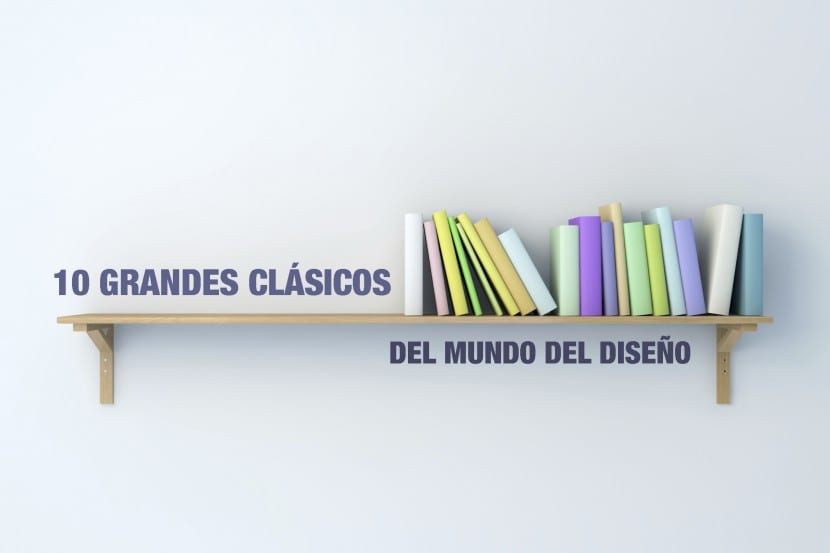
Today is book day and what better way to celebrate it than by making a small selection of the most representative works in the world of graphic design? Since Creativos Online We want to celebrate it with you by remembering (and recommending if you don't know them) a series of very interesting books on graphic design.
Surely you already know some of them, because as I say they are references of our field. If you have any recommendation on any reading that may be of interest, do not hesitate to tell us through a comment.
- The elements of design. Style guide for graphic designers from Timothy Samara: It is a manual that analyzes in a very precise way the basis of the fields of the profession, from typography to layout, color management, spatial management ... In this wonderful copy we are offered a set of very valid advice that They do not contradict the principles of design at all, although alternatives are also provided for those houses where it is "necessary" to transgress certain norms.
- How are objects born? Notes for a project methodology from Bruno Munari: Perhaps one of the books that most fully touches on the process of creating and developing new ideas. In this work the author systematically analyzes the path that the designer takes from the moment he faces a functional problem until he projects and configures a material solution.
- World of art from Thames and Hudson: It is a tremendously good series that also exists in its Spanish version co-edited by Ediciones Destino in the El mundo de Arte collection. This comprehensive study deals with all the aspects that characterize modern design in any of its variants: graphic design, interiors, product, industrial design, furniture, and architecture. Perhaps the most interesting thing about this series is that the author does not limit himself solely to studying the great designers of world projection, but also takes into account many dramatic changes that have influenced the world of graphic design since 1900. Political and ideological concepts , how feminism and green design are defined and explained, as are technological advances, new materials and techniques, and the most influential movements in modern culture. The text contains cross-references and full bibliographic notes, along with a chronological table of design highlights.
- Graphic Design, A Concise History from Richard Hollis, Thames & Hudson: Perhaps one of the best works to delve into the birth, evolution, and predict the future of graphic design. Its last chapter brings together all the events and events that have had an international impact and the great personalities of design in recent years as well as the impact that digital technology has had.
- Dictionary of Graphic Design and Designers from Alan Livingston, Isabella Livingston, Thames & Hudson: This global reference work provides indispensable information on typographers, magazines, movements and styles, organizations and schools, printers, art directors, technological advancements, design studios, graphic illustrators and poster artists. Extensive cross-references and a chronological chart - describes the relationship between movements, technology and designers. With the emergence of the internet as a platform for design, marketing and advertising technology, an essential guide, it remains a key book for students and professionals around the world.
- Dictionary of Art and Artists from Herbert Read, Nikos Stangos, Thames and Hudson: An international book to date, this widely illustrated cross-reference dictionary offers information on more than 2500 artists, paintings, sculptures, drawings, prints, schools, and movements, including essential information on art and artists. Talk about the techniques, materials, terms, and writings that have influenced artists. An indispensable reference book for a graphic designer.
- The art of color from Johannes Itten: It is an academic, precise and clean classic that is perfect for understanding the basic principles of color and how they interact with each other. One of its strengths is that it combines the thematic line with various elements that go beyond the color itself, such as the interesting Gestalt theories, such as the shape and the counterform.
- The syntax of the image, introduction to the visual alphabet by Donis A. Dondis: This classic introduces us to the normative system of the language of the image. It is characterized by perfectly combining its more theoretical facet with that more practical one where everything mentioned is illustrated with examples included in the world of art and the visual through painting, sculpture, audiovisuals or architecture.
- Typography Manual by Jose Luis Martín and Montse Ortuna: This manual stands out for its fluid and complete character in dealing with the history of typography and its evolution through the milestones that have changed the course of the matter. On the other hand, the different families of fonts, their classification and the different forms of construction and composition are also analyzed and shown.
- Aesthetic theory from Theodor Adorno: This book makes a most interesting exposition on the author's own aesthetic theory in which his conceptions of art are collected, also on a more philosophical level and without giving up the more historical facet. Ideal to expand our field of vision and enrich ourselves at a conceptual level.